Canadian History With New Eyes: The Dark Ages?
The Dark Ages & the French Wars of Religion Some time ago, I started to
Home / War of 1812 – Fur Traders And Native Allies
The battles in the War of 1812 were fought largely on Lakes Ontario and Huron. The question is still asked, ‘Who won the War of 1812?’ As in all wars, both the United States and Upper Canada won some and lost some battles.
Here is some coverage of what happened around Lake Huron, as told by the historical plaques of Sault St. Marie.
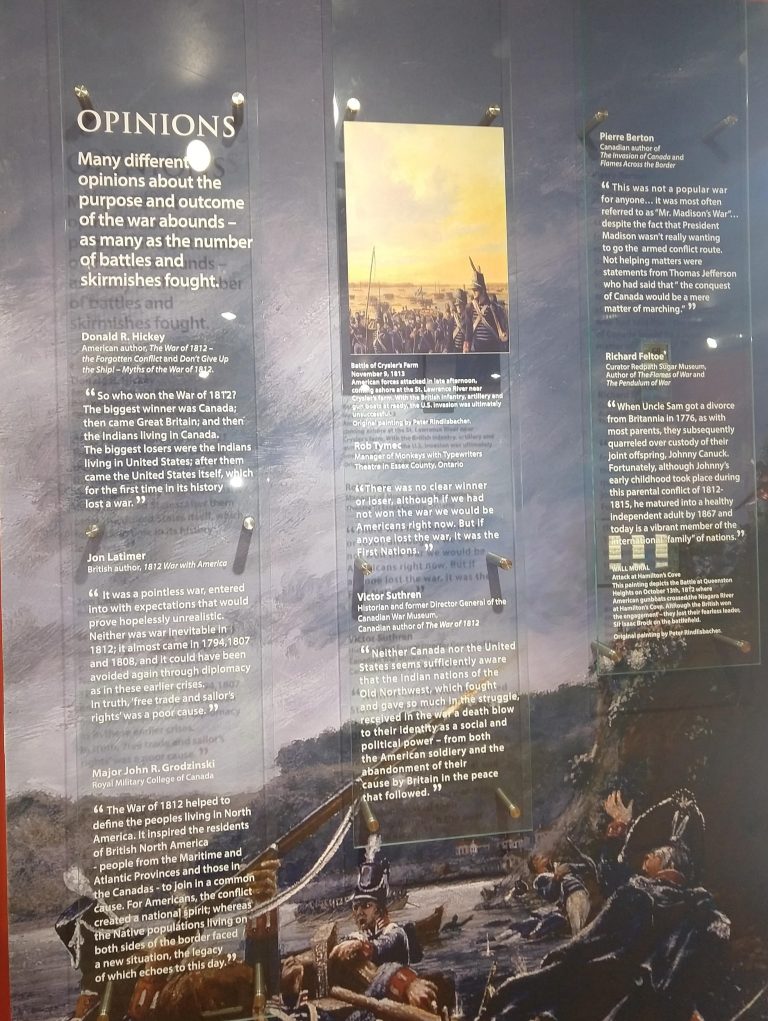
This plaque begins with the assertion, ‘many different opinions about the purpose and outcome of the war abounds – as many as the number of battles and skirmishes fought’.
American author Donald Hickey in his books, The War of 1812- the Forgotten Conflict and Don’t Give Up The Ship! Myths of The War of 1812, claims that the biggest winners were Britain and the Natives living in Canada and the biggest loser was the US.
British author Jon Latimer claims that ‘free trade and sailors’ rights’ was a poor excuse for an avoidable, pointless war which diplomacy could have avoided.
Major John Grodzinski from the Royal Military College Canada expressed the opinion that the outcome was national unity for both the Americans and the Canadian colonies. However, it changed the lives of Natives living on both sides of the border.
My favourite commentary is this one by Richard Felton, Curator of Redpath Sugar Museum who wrote, ‘The Flame of War and The Pendulum of War’: “When Uncle Sam got a divorce from Britannia in 1776, as with most parents, they subsequently quarreled over their joint offspring, ‘Johnny Canuck’. Fortunately, although Johnny’s early childhood took place during this parental conflict of 1812-1815, he matured into a healthy independent adult by 1867 and today is a vibrant member of the ‘international family’of nations'”.
Check out the other sources listed on this plaque.
In June 1812, Major General Isaac Brock sent urgent requests to Captain Roberts at Fort St. Joseph on the shores of St. Joseph Island and to Robert Dickson, fur trader and Native persuader from the Michilimackinack territory to rally their forces and prepare for the takeover of American-ruled Fort Mackinac.
The British garrison at Fort St, Joseph was comprised of forty-four officers of the 10th Royal Veteran batallion, two gunners from the Royal Artillery, storekeeper John Askin, Jr., and a group of women and children.
By July 8, Brock in York (Toronto) dispatched a team of twelve Voyageurs in an ‘express canoe’ to travel the 2,000 kilometres upriver to travel to the fort to notify Roberts and Dixon that the war had begun.
Roberts requisitioned guns, supplies and made ready Caledonia, the 70-ton schooner owned by the North West Company. Dixon rallied a strong team of Native Chiefs and Warriors.
Charles Oakes Ermatinger and John Johnson, fur traders of both sides of the St. Mary’s River, in Sault Ste Marie gathered their Native allies and French Canadian Voyageurs and travelled by canoe to Fort St. Joseph.
The troops were now assembled and ready for the attack on Mackinac.
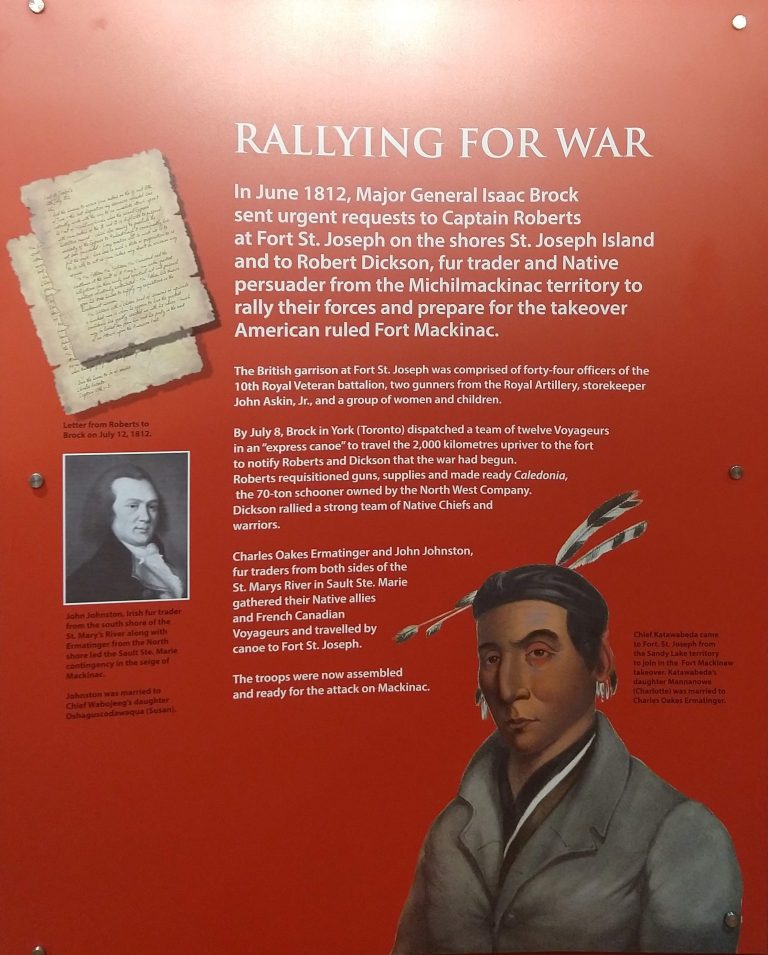
This plaque gives a timeline of events which is very interesting. Some of these important players in the war were unknown to me until now.
I’ve heard of Brock and Tecumseh, but have you heard of Captain Roberts?
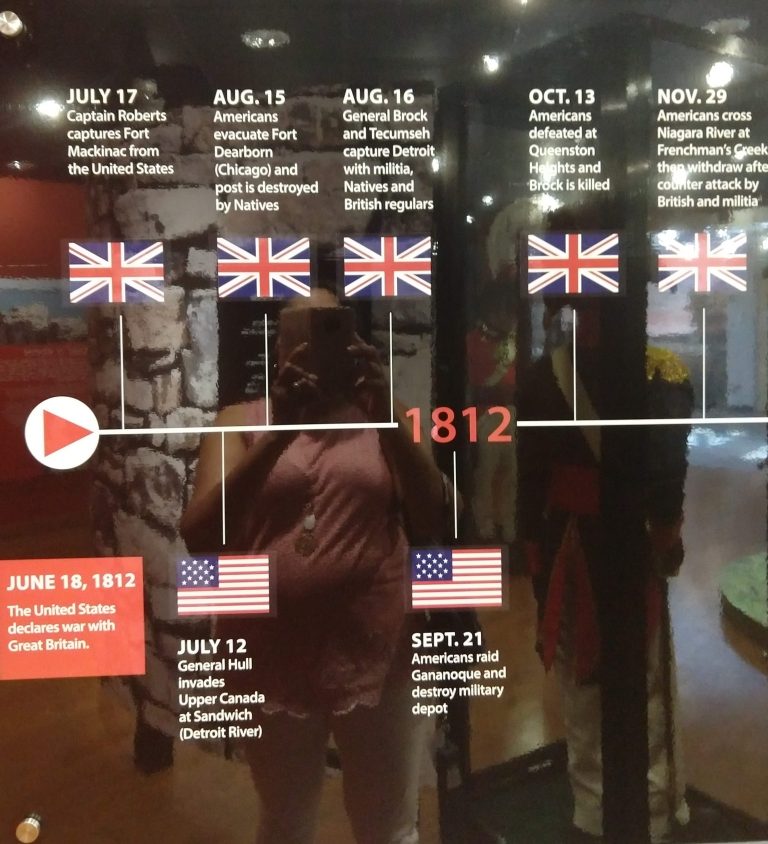
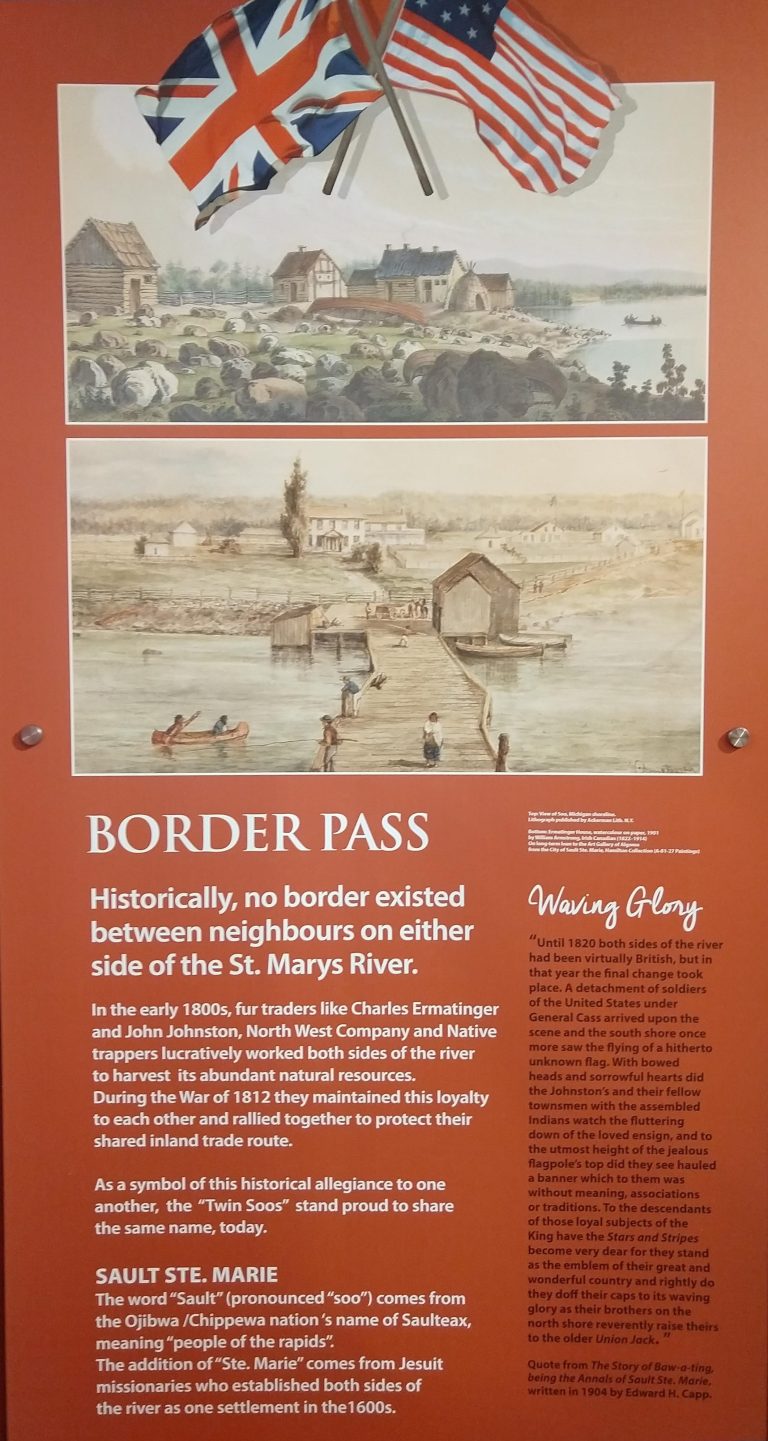
Just so you know…
Historically, no border existed between neighbours on either side of the St. Mary’s River.
In the early 1800s, fur traders like Charles Ermatinger and John Johnson, North West Company and native trappers lucratively worked both sides of the river to harvest its abundant natural resources.
During the War of 1812 they maintained this loyalty to each other and rallied together to protect their shared inland trade route.
As a symbol of this historical alliegance to one another, the ‘Twin Soo’ stand proud to share the same name today.
Sault Ste Marie
The word ‘Sault’ (pronounced “soo”) comes from the Ojibwa / Chippewa nation’s name Saulteax meaning ‘people of the rapids’. The addition of Ste Marie comes from the Jesuit missionaries who established both sides of the river in the 1600s.
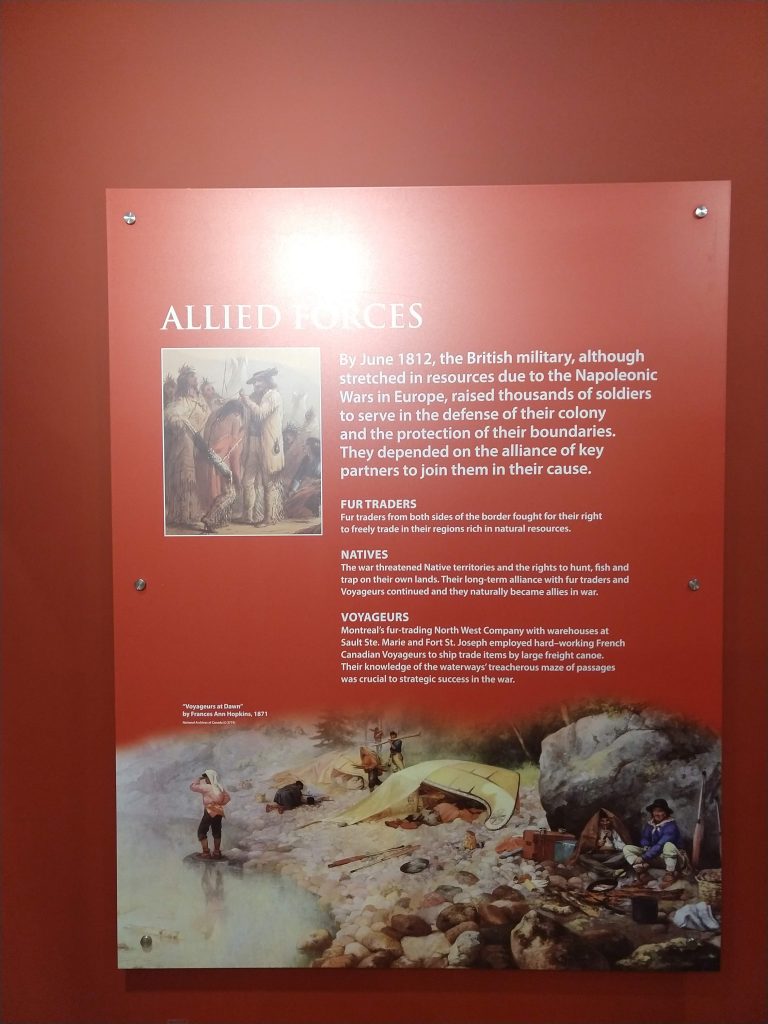
By June 1812, the British military, although stretched in resources due to the Napoleonic Wars in Europe, raised thousands of soldiers to serve in the defence of their colony and the protection of their boundaries.
Fur Traders
Fur traders from both sides of the border fought for their right to freely trade in their region rich in natural resources.
Natives
The war threatened Native territories and the right to hunt, fish and trap on their own lands. Their long term alliance with fur traders and Voyageurs continued and they naturally became allies in war.
Voyageurs
Montreal’s fur-trading North West Company with warehouses at Sault Ste. Marie and Fort St. Joseph employed hard-working French Canadian Voyageurs to ship trade items by large freight canoe. Their knowledge of the waterways’ treacherous maze of passages was crucial to strategic success in the war.
The British military post at Michilimackinac was transferred to the United States in 1796 by mutual agreement and the forces stationed there retired to St. Joseph Island where blockhouse, powder magazine, bakery building, Indian council house and storehouse surrounded by a palisade were erected in 1801.
Situated on approximately 325 hectares along the St Mary’s River Fort St. Joseph was the staging ground for the initial attack in the War of 1812. During its short but illustrious operation , it was the British Empire’s most westerly outpost. Today, Fort St Joseph is operated by Parks Canada and is designated a National Historic Site of Canada.
At the end of the war, Fort Mackinac was returned to the Americans and although the British still used the Fort St. Joseph powder magazine they decided to build their new fort at Drummond Island (between St Joseph and Michilimacinack). In 1825, it was decided that Drummond Island was in US territory so the British garrison moved to Penetanguishine.
(see the timeline of activities)
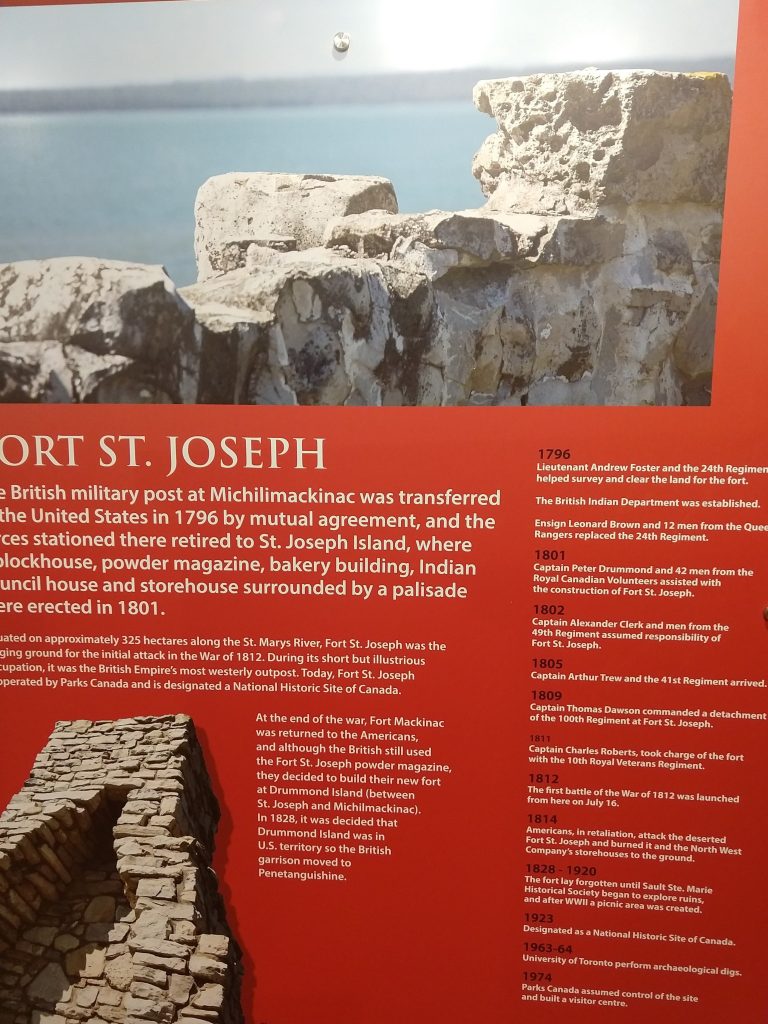
In the next few articles on the War of 1812, we will look at historical plaques and markers which record some of the events which occured on Lake Ontario.
We will also investigate some of the names involved in that war as we highlight the history left for us at forts museums and other sites which act as repositories of our history. Some of this information you will not find in textbooks.
Author’s Note: Lynette is the owner of ChristianRoots Canada. Blogger. Publisher. Course Creator. Passionate about Canadian History from the perspective of God’s Providence.
The Dark Ages & the French Wars of Religion Some time ago, I started to
In many places, like legislatures and schools, the Bible is considered ‘hate literature’. Counseling someone
Britain’s claim of Rupert’s Land by the Doctrine of Discovery, proved to be one of
Dominion Day had been a federal holiday that celebrated the enactment of The British North American Act which united four of Britain’s colonies – Nova Scotia, New Brunswick, Upper and Lower Canada (which became Ontario and Quebec), into a single country within the British Empire, and named that country The Dominion of Canada.